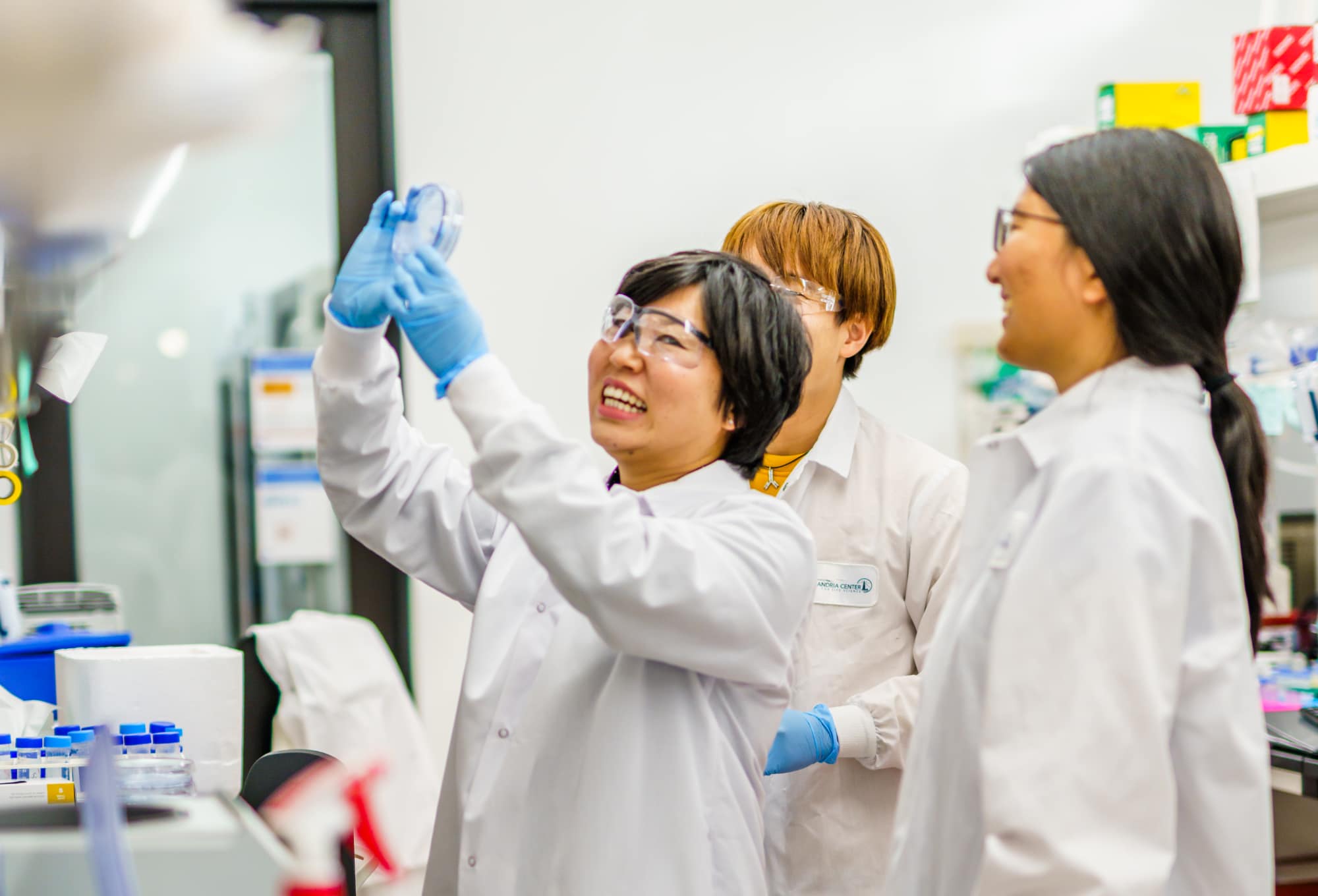A chat with Lingyin Li
 Next in our Arc Investigator Profiles series, we caught up with Lingyin Li. In addition to her Core Investigator role at Arc, Lingyin is an Associate Professor in the Biochemistry Department and ChEM-H Institute at Stanford, where her lab has contributed several breakthrough discoveries to transform our understanding of innate immunity. She has pioneered the development of chemical tools to better understand, manipulate, and drug immune pathways, with an eye toward harnessing innate immunity to fight cancer. Among many other honors, Lingyin was recently recognized as the 2022 recipient of the Eli Lilly Award in Biological Chemistry.
Next in our Arc Investigator Profiles series, we caught up with Lingyin Li. In addition to her Core Investigator role at Arc, Lingyin is an Associate Professor in the Biochemistry Department and ChEM-H Institute at Stanford, where her lab has contributed several breakthrough discoveries to transform our understanding of innate immunity. She has pioneered the development of chemical tools to better understand, manipulate, and drug immune pathways, with an eye toward harnessing innate immunity to fight cancer. Among many other honors, Lingyin was recently recognized as the 2022 recipient of the Eli Lilly Award in Biological Chemistry.
We’re so happy to have you at Arc, Lingyin! Tell us about the research in your lab.
My lab currently focuses on understanding a key pathway in our innate immune system called STING. STING is a fascinating cornerstone defense mechanism, but also a major culprit in autoimmune diseases. The STING pathway senses and mounts an immune response against misplaced DNA in our cells: a common molecular indicator of viral infection or cancer.
We’re interested in figuring out what activates STING, as well as what negatively regulates it. Our ultimate goal is to manipulate the pathway to benefit patients with cancer or autoimmune diseases. To tackle these big questions, we use a combination of many different techniques, including structural biology, biochemistry, genetic screens, cell biology, and mouse tumor immunology.
What inspired you to work on STING?
Through my undergraduate and PhD training, I always knew I wanted to make an impact on human health with whatever tools were at my disposal. Then, cancer biology became personal: soon after I started my postdoctoral training and married my childhood best friend at the age of 30, I was diagnosed with invasive ductal carcinoma, a form of breast cancer. My prognosis at the time was unclear, particularly because I was so young. So you can imagine my life was turned upside down. I chose the most aggressive treatment, which thankfully put me in remission, but not without adverse consequences. Perhaps as a sort of coping mechanism, I focused my subsequent research on cancer.
When I first started investigating cancer biology, it was known that if you could get more immune cells to infiltrate tumors, the better the outcome would be. There was an experimental drug named DMXAA that boosted immune cell numbers in mouse tumors but failed human clinical trials. Working with a colleague, I discovered that DMXAA activates anti-cancer immune responses in mice by binding and activating mouse STING, but the drug did not work in people because it does not bind or activate human STING. This work, together with others’, put the STING pathway on the map for cancer immunotherapy — and I was hooked!
What are some recent highlights of your lab’s work?
We’ve been busy over the past few years! My lab showed that the chemical messenger of the STING pathway, cGAMP, is pumped out of cancer cells and sensed by other nearby cells to sound the immunological alarm on cancer. This cGAMP signaling is responsible for the immune infiltration following radiation treatment, and in fact it is an essential part of how radiation therapy can be curative. Other work from the lab has identified transporter channels that cells use to import the cGAMP signaling molecule. Interestingly, we also showed that some cancer types make an enzyme that degrades cGAMP, effectively silencing that signal to evade our immune system. We believe that inhibiting that degradative enzyme could boost immunity against the tumor.
How do you envision taking these findings toward developing new cancer therapies?
Cancer is not one disease. Even breast cancer is not just one disease. And the mechanisms that different cancer types use to evade our immune detection are drastically different. That’s why we aim to find a middle ground for cancer therapies that are somewhat tailored, but can treat a large enough portion of the patient population that they are scalable. Ideally, patients can be stratified into different groups based on molecular signatures of their specific cancer type, helping us pick the right therapeutic strategy for each person.
Targeting innate immune checkpoints like the STING pathway is one of many ways to tackle cancer, but a powerful one: innate immunity is one of our frontlines of defense, and so more patients are likely to benefit from innate immune-targeted therapies. A big general goal of my lab is to understand in what contexts the STING pathway is important or detrimental and identify what subset of patients will benefit from a drug that targets the STING pathway.
In terms of specific therapeutic targets, our recent work showed how the ENPP1 enzyme acts as a negative regulator of the STING pathway by degrading cGAMP. By inhibiting ENPP1, we would be able to block that degradation to re-activate and harness the strong downstream anti-cancer immune response. Taking advantage of the medicinal chemistry knowledge center led by Dr. Mark Smith at Stanford ChEM-H, we developed best-in-class ENPP1 inhibitors that exerted remarkable tumor shrinkage effects in mice. To realize these inhibitors’ full potential and see them through clinical trials, I co-founded Angarus Therapeutics. Angarus is Latin for “messenger”, referring to cGAMP. Angarus’ lead ENPP1 inhibitor has been granted Investigational New Drug (IND) status and patient recruitment for its first clinical trial will begin soon.
What excites you about joining Arc?
There are so many exciting aspects! An obvious one is that we can unapologetically do the most impactful research on a time scale that is more realistic for therapeutic development. Another exciting thing that jumps into my mind is the energy that Silvana and Patrick bring to Arc. They have this can-do attitude that leaves my students really inspired to tackle difficult challenges. And working with such strong female leaders at Arc is refreshing and extremely effective!
I have always been perhaps overly ambitious in what I wanted to do. I’m just not interested in the small questions, and I had a strong urge to make an impact on human health from the beginning of my career. While there are specific NIH grants geared toward young investigators doing high-risk, high-reward research — and those largely fueled our lab’s research up until now — the current academic system is not as encouraging for “old” innovators to take their research in high risk directions. Instead, it becomes extremely difficult to compete for limited funding, and “safer” next steps are generally funded over more ambitious big-picture projects. With its focus on unconstrained funding and allowing investigators to pursue whichever ambitious research projects they set their sights on, I feel like Arc is personally designed for someone like me!

How have things changed in your lab since moving to Arc a few months ago, and how do you anticipate your lab will change over the next few years at Arc?
I definitely noticed that our mentality changed. Now, there is nothing we cannot do; only ideas we cannot think of. We’ve been really positively influenced by other Arc labs, moving toward approaches that will allow us to generate large and powerful datasets. We’re collaborating with the Gilbert lab on single cell approaches, as well as genetic methods to control the STING pathway. I also really look forward to working with biotechnology experts in Arc’s Technology Centers — specifically, genomics and proteomics experts in the Multi-omics Center — to develop new ways to understand STING at a deeper level.
While our lab has largely been focused on the STING pathway in cancer, I’m also really interested to figure out how it contributes to neuroinflammation, and we’re planning to work with the Konermann lab to start new projects in that space. Over the next several years, there are so many other disease contexts we are excited to look at from the STING pathway perspective: Parkinson’s, ALS, heart attack, and autoimmune diseases like lupus, just to name a few.
Finally, with guaranteed funding, we have quadrupled our mouse genetics efforts. For every new regulator of the STING pathway we have identified, we can now have a transgenic mouse model, and those will be really powerful tools for our research going forward. A few of the targets we discovered are unique to humans and cannot be tested in mouse models, so I’d like to work with the Cellular Models Center to model complex immune interactions with human cells and test new therapeutic directions that way.
How did you get into science?
I was actually born into a family of scientists. My grandfathers on both sides (and many of their siblings!) are university professors, specifically working in biochemistry and biology. My own parents are not highly educated, but they’re very inquisitive. My mom is always conducting experiments and tweaking things to see if she can make it better. She does this in everyday life, even with her cooking, which is never the same day to day. And most of the time it's a failure. There's a saying, "If it ain’t broke, don't fix it." And she's the opposite of that: Break it to figure out if it can be better. I think the most important thing for a scientist is a strong role model, and there's no better role model than your mother.
What is your favorite thing about mentoring students and postdocs?
Our lab is very geographically, scientifically, and culturally diverse — and their diverse backgrounds bring in so much creativity and curiosity. We observe and respect each other with our eyes wide open, and I encourage all my trainees to follow their passions and explore new disciplines. Remarkably, all three of my chemistry students now do mouse work — not just testing chemicals, but hardcore mouse genetics and disease models. They think outside the box because they simply do not know where the “box” in the new discipline is.
My favorite thing about being a mentor is the growth experiences for both me and my trainees. What I consider a success is when we come up with ideas that neither me or my student could come up with alone, and together we achieve something that neither of us could achieve alone. As often as I am the sounding board for my trainees, they are the sounding board for me. I love it when they poke holes in my ideas and keep me on my toes. I love it when they think I am stupid. I have the reputation of being able to encourage and support trainees to achieve something that they never thought they could. But they often don’t realize that they do the same for me!

